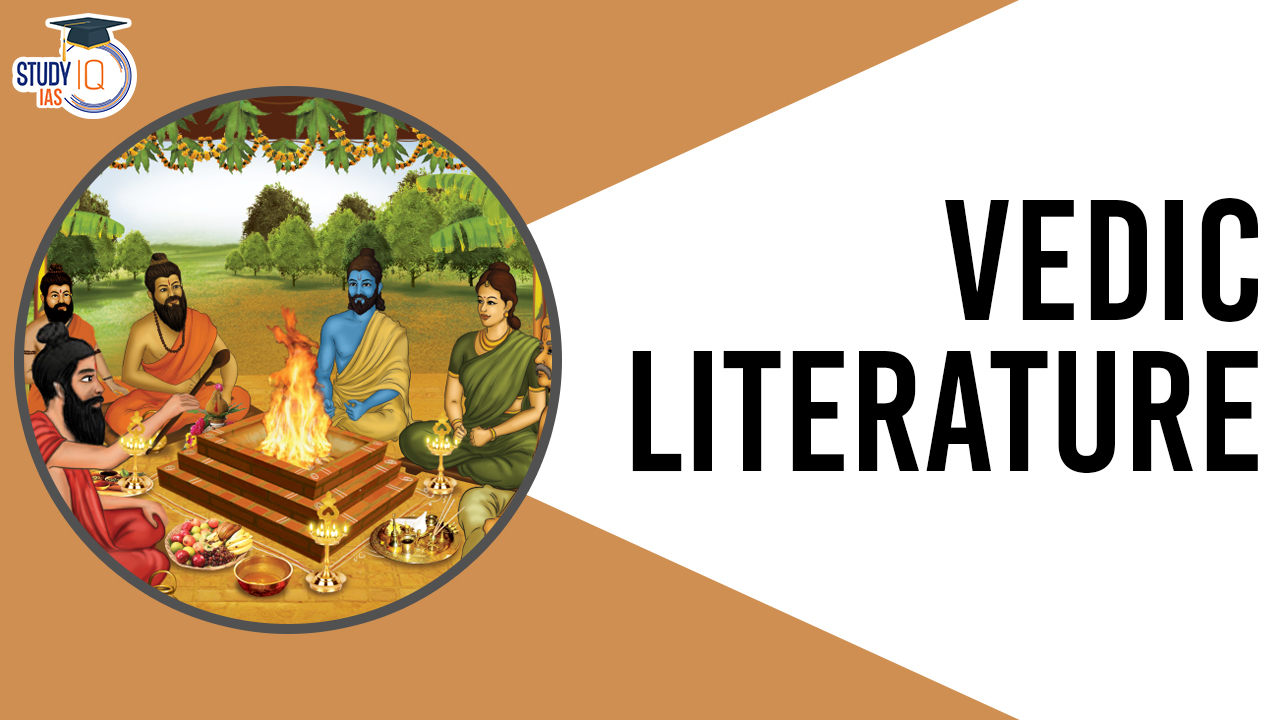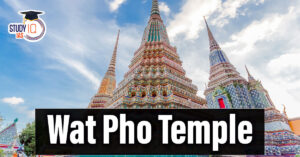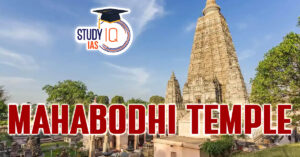Table of Contents
Vedic Literature refers to the ancient sacred texts that form the foundation of Hinduism. These texts are among the oldest religious scriptures in the world and are considered the authoritative source of knowledge in various fields, including philosophy, theology, science, and ritual. The term “Vedic” is derived from the Sanskrit word “Veda,” which means knowledge or wisdom. The Vedic Literature is classified into four main categories: Samhitas, Brahmanas, Aranyakas, and Upanishads. Each category serves a specific purpose and contributes to the comprehensive understanding of Vedic philosophy and spirituality.
We’re now on WhatsApp. Click to Join
What is Vedic Literature?
The ancient and sacred texts of Hinduism were penned in the initial era’s Sanskrit, encompassing the Samhitas, Brahmanas, Aranyakas, and Upanishads in traditional belief. These Vedas stand as a testament to India’s profound cultural and religious traditions, encapsulating the essence of the nation’s heritage.
Their significance lies in more than just language; it extends to the richness of expression, understanding, and profound insights they offer. The Vedic literature serves as a repository of detailed information, providing insights into the socio-cultural origins of ancient India, the prevailing way of life, intricate rituals and ceremonies, societal norms, and the profound teachings of ancient Indian wisdom. This literary heritage not only reflects the cultural exuberance of the country but also serves as a timeless source for understanding the roots and evolution of Indian civilization.
Types of Vedic Literature
Vedic literature is broadly categorized into two main types: Shruti literature and Smriti literature, constituting the oldest Hindu writings and the earliest Sanskrit literature. The Vedas, regarded as the foundational scriptures, have been transmitted across generations through oral tradition. Let’s delve into each category in more detail:
Shruti Vedic Literature
Shruti literature comprises writings that hold fundamental significance in Hinduism, recognized for their profound insights and considered as repositories of indisputable truths. This category includes:
- Vedas: The core and oldest texts, the Vedas are divided into four parts – Rigveda, Samaveda, Yajurveda, and Atharvaveda. Each Veda consists of Samhitas (hymns), Brahmanas (rituals and ceremonies), Aranyakas (forest texts), and Upanishads (philosophical teachings).
| S. No | Vedas | Composed Time Period | Features |
| 1 | Rig Veda | 1700 BC | Oldest and most significant Veda. – Contains 1028 hymns in ten books (mandalas) dedicated to various gods, including Indra, Agni, Vishnu, Rudra, Varuna, and other early Vedic deities. – Includes the renowned Gayatri mantra and the Purusha Shukta prayer, narrating the story of Primal Man. |
| 2 | Yajur Veda | 1000 and 800 BCE | Considered the ritual book. – Written approximately one or two centuries after the Rig Veda. – Signifies sacrifice (Yajur). – Divided into two parts: the older “black”/”dark” (Krishna Yajur Veda) section and the more current “white”/”bright” (Shukla Yajur Veda) section. – Functions as a priestly manual for yajnas (sacrifices). |
| 3 | Sama Veda | 200 or 1000 BCE | Comprised of chants and melodies used in worship and yajna rituals. – Specifically created for ritualistic contexts, with words recited during soma sacrifice rituals. – Shortest among the four Vedas. – Connected to the Rig Veda. |
| 4 | Atharva Veda | 1000-800 BCE | Often referred to as the Veda of magic formulas. – Contains hymns, mantras, and incantations that fall outside the purview of yajna (sacrifices). |
- Brahmanas: These texts provide detailed explanations and instructions for the rituals and ceremonies mentioned in the Vedas. They offer a deeper understanding of the symbolic significance behind the rituals.
- Aranyakas: Bridging the gap between the ritualistic Brahmanas and the philosophical Upanishads, Aranyakas are associated with hermits and ascetics dwelling in the forest, focusing on contemplative practices.
- Upanishads: Representing the culmination of Vedic thought, Upanishads explore profound philosophical concepts, such as the nature of reality (Brahman) and the self (Atman). They encourage introspection and meditation for spiritual realization.
Check Here: Rig Vedic Period
Smriti Vedic Literature
In contrast, Smriti literature refers to works composed after the Vedic period and is often considered as remembered or traditional literature. This category includes:
- Puranas: These are vast compilations of myths, legends, and genealogies of gods, goddesses, and heroes. Puranas serve to disseminate religious and moral teachings in a narrative form.
- Upangas: Supplementary limbs of the Vedas, the Upangas cover various subjects, including grammar, metrics, astronomy, and law.
- Tantras: Focused on rituals, meditation, and worship, Tantras provide instructions for various spiritual practices.
- Upveda: Comprising four disciplines associated with each Veda – Ayurveda (related to medicine), Dhanurveda (archery and war), Gandharvaveda (music and performing arts), and Sthapatyaveda (architecture).
- Itihasa: Epic narratives, including the Ramayana and Mahabharata, which offer moral and philosophical teachings through captivating stories.
Check Here: Later Vedic Period
Vedic Literature – Vedas
The Vedas, foundational texts of Hinduism, are classified into four types:
- Rig Veda: The oldest and most significant Veda, consisting of hymns dedicated to various deities. Notable for its portrayal of early Vedic gods and includes the famous Gayatri mantra and Purusha Shukta.
- Sama Veda: Comprised of chants and melodies used during worship and rituals. Linked to the Rig Veda, it is the shortest of the four Vedas.
- Yajur Veda: Known as the ritual book, it provides guidelines for sacrificial ceremonies. It is divided into the Krishna Yajur Veda and Shukla Yajur Veda.
- Atharvaveda: Often referred to as the Veda of magic formulas, it contains hymns and incantations addressing various aspects of life outside the scope of traditional sacrifices.
Check here: Difference Between Early and Later Vedic Periods
Vedic Literature – Brahmanas
Brahmanas are prose texts embedded within each Veda, explaining the hymns and incorporating myths and legends. They serve as instructional material for Brahmins, detailing Vedic rituals. Brahmana literature also explores scientific knowledge, including observational astronomy and geometry related to altar construction. Some Brahmanas contain mystical and philosophical content, leading to the development of Aranyakas and Upanishads.
- Each Veda has its own Brahmanas, associated with specific Shakhas or Vedic schools.
- Fewer than twenty Brahmanas are extant today due to loss or destruction.
- The dating of Brahmanas is controversial, with the oldest dated around 900 BCE and the youngest around 700 BCE.
Vedic Literature – Aranyakas
Aranyakas, known as “Forest Books,” interpret sacrificial rituals in a symbolic and philosophical manner. They serve as a transition from external rituals to more internal, contemplative practices.
Vedic Literature – Upanishads
Upanishads are philosophical texts that explore profound ideas. Key points include:
- There are 108 Upanishads, with 13 considered major.
- Upanishads delve into the concepts of ‘Atman’ (individual self) and ‘Brahman’ (universal consciousness).
- They philosophically explore ideas related to sacrifice, the body, and the universe.
Vedic Literature – Vedangas
Vedangas, referred to as the limbs of the Veda, are six auxiliary disciplines essential for understanding and interpreting the Vedas. Mentioned in the Mundaka Upanishad, the Vedangas include:
- Siksha (pronunciation): Focuses on the correct pronunciation and phonetics of Vedic mantras.
- Kalpa (rituals): Deals with the procedures and rituals associated with Vedic ceremonies.
- Vyakarana (grammar): Concerned with the grammatical rules for understanding the Vedic texts.
- Nirukta (etymology): Involves the interpretation of Vedic words and their etymology.
- Chhanda (meter): Explores the meters and rhythms used in Vedic poetry.
- Jyotisa (astrophysics): Pertains to Vedic astronomy and timekeeping.
Vedic Literature – Shad-Darshana
The Shad-Darshana encompasses six schools of philosophical thought in India, each presenting distinct perspectives on life and existence. These are:
- Uttara Mimamsa: Concerned with the interpretation of the latter part of the Vedas, specifically the Upanishads.
- Nyaya: Deals with logic and reasoning.
- Vaisheshika: Explores atomic theory and metaphysics.
- Sankhya: Focuses on enumeration and the concept of dualism.
- Yoga: Explores the practice of spiritual discipline and meditation.
- Purva Mimamsa: Concerned with the interpretation of the earlier part of the Vedas, particularly the rituals and ceremonies.
These philosophical texts are written in a concise, direct, and aphoristic (Sutra) style, aiming to spread the values of righteous living.
Puranas
Puranas are sacred texts providing a wealth of information on creation, ancestral lineage, moral guidelines, various worlds, and myths. While considered newer than the Vedas, they discuss the “later deities” like Brahma, Vishnu, and Shiva. Some well-known Puranas include Devibhagavata, Bhagavata, and Vishnu-Puranas.
Itihasas
Itihasas, such as the Ramayana and Mahabharata, are epic narratives. The Ramayana, authored by Maharishi Valmiki, consists of 24,000 verses, while the Mahabharata, composed by Maharishi Vyas, contains 100,000 verses.
Tantras
Tantras encompass three main categories: Shaiva, Shakta, and Vaishnava. Tantric Literature, not consistently coherent, is primarily concerned with theistic worship and can include Agamas, Nigamas, and Samhitas. Saiva Tantras are often referred to as Agamas, Vaisnava Tantras as Samhitas, and Sakta Tantras as Tantras.
Agamas
Agamas are instructional guides for deity worship, including Tantras, Mantras, and Yantras. They provide guidance on how to worship deities outside the body, such as in idols and temples, emphasizing four attributes: Jnana (Knowledge), Yoga (Concentration), Kriya (Esoteric Ritual), and Charya (Exoteric Worship).
Upavedas
Upavedas encompass four traditional branches of applied knowledge:
- Dhanurveda (art of warfare): Deals with military strategy and tactics.
- Gandharvaveda (music): Explores musical theory and practice.
- Silpaveda (art and architecture): Concerned with artistic principles and architectural design.
- Ayurveda (medicine): Focuses on traditional medical knowledge and practices.
Importance of Vedic Literature
- Spiritual Wisdom: Vedas, especially Upanishads, contain profound philosophical insights and spiritual teachings.
- Religious Guidance: Vedic literature provides detailed instructions for Hindu rituals, ceremonies, and sacrifices.
- Moral Lessons: Puranas and Itihasas embed moral and ethical teachings in mythological narratives.
- Historical Record: Offers glimpses into the socio-cultural aspects and lifestyle of ancient India, aiding in historical reconstruction.
- Linguistic Foundations: Vedangas, particularly Vyakarana, contribute to Sanskrit linguistics and grammar development.
- Astrological and Scientific Insights: Jyotisa in Vedic literature provides ancient Indian astronomy and scientific knowledge.
- Cultural Identity: Shapes the cultural identity of India and contributes to a shared heritage among its people.
- Basis for Later Texts: Many later Hindu scriptures draw inspiration and references from Vedic literature.
- Unity in Diversity: Serves as a common thread uniting followers across diverse Hindu sects and traditions.
Vedic Literature UPSC
Vedic literature, foundational to Hinduism, is a rich tapestry encompassing the Vedas, Upanishads, Brahmanas, and more. The Rig Veda, Sama Veda, Yajur Veda, and Atharvaveda constitute the core Vedas. They offer spiritual wisdom, ritual guidance, and moral lessons. Vedangas provide linguistic and grammatical foundations, while Puranas contribute historical and cultural insights. The Itihasas, including Ramayana and Mahabharata, narrate epic stories. The importance of Vedic literature lies in shaping Hindu philosophy, providing historical records, and influencing cultural identity, making it a pivotal topic in the UPSC examination for its multifaceted impact on India’s heritage.


 Chittorgarh Fort: Mining Ban within 10 k...
Chittorgarh Fort: Mining Ban within 10 k...
 PM Modi visits Wat Pho Temple in Bangkok
PM Modi visits Wat Pho Temple in Bangkok
 Mahabodhi Temple Complex at Bodh Gaya
Mahabodhi Temple Complex at Bodh Gaya





















